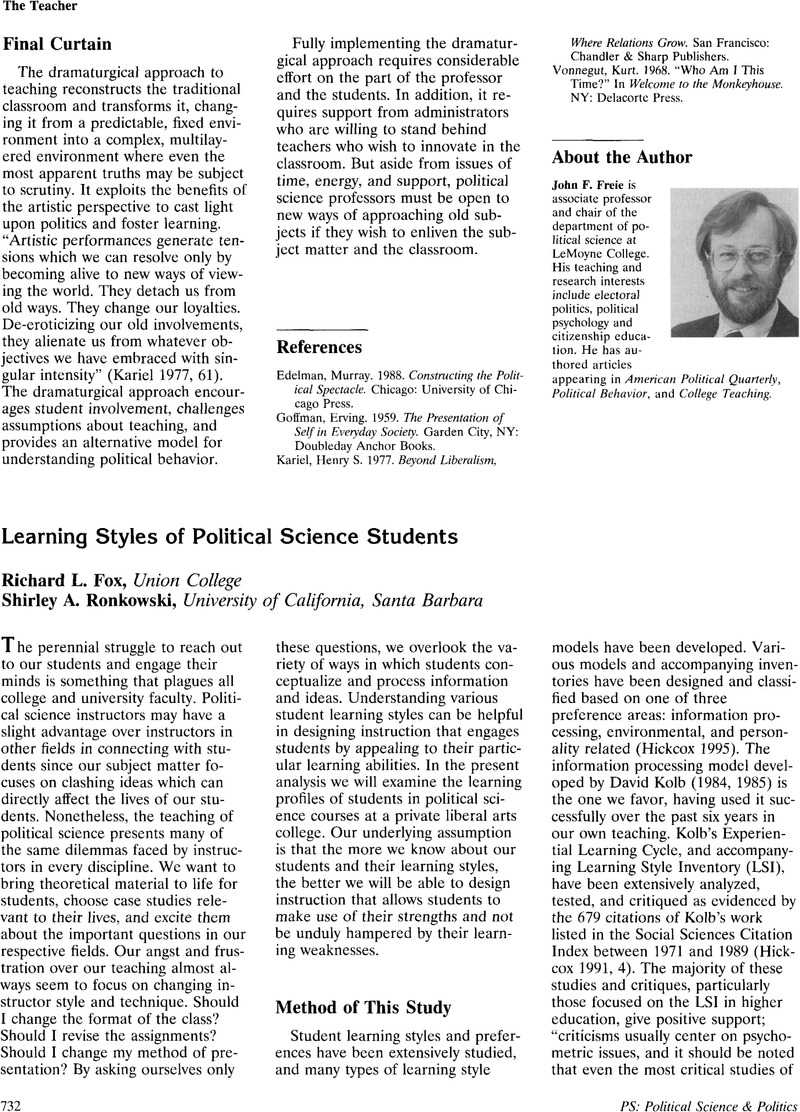Crossref Citations
This article has been cited by the following publications. This list is generated based on data provided by Crossref.
Rosenthal, Cindy Simon
1999.
One Experience is Worth a Thousand Words: Engaging Undergraduates in Field Research on Gender.
PS: Political Science & Politics,
Vol. 32,
Issue. 1,
p.
63.
Brock, Kathy L.
and
Cameron, Beverly J.
1999.
Enlivening Political Science Courses with Kolb's Learning Preference Model.
PS: Political Science & Politics,
Vol. 32,
Issue. 2,
p.
251.
Kathlene, Lyn
and
Choate, Judd
1999.
Running for Elected Office: A Ten-Week Political Campaign Simulation for Upper-Division Courses.
PS: Political Science & Politics,
Vol. 32,
Issue. 1,
p.
69.
Box-Steffensmeier, Janet M.
Grant, J. Tobin
Meinke, Scott R.
and
Tomlinson, Andrew R.
2000.
Virtual Field Trips: Bringing College Students and Policymakers Together through Interactive Technology.
PS: Political Science & Politics,
Vol. 33,
Issue. 4,
p.
829.
Robinson, Tony
2000.
Service Learning as Justice Advocacy: Can Political Scientists Do Politics?.
PS: Political Science & Politics,
Vol. 33,
Issue. 3,
p.
605.
Ishiyama, John
and
Breuning, Marijke
2003.
Does Participation in Undergraduate Research Affect Political Science Students?.
Politics & Policy,
Vol. 31,
Issue. 1,
p.
163.
ERNST, HOWARD R.
and
ERNST, TRACEY L.
2005.
The Promise and Pitfalls of Differentiated Instruction for Undergraduate Political Science Courses: Student and Instructor Impressions of an Unconventional Teaching Strategy.
Journal of Political Science Education,
Vol. 1,
Issue. 1,
p.
39.
Damron, Danny
and
Mott, Jonathan
2005.
Creating an Interactive Classroom: Enhancing Student Engagement and Learning in Political Science Courses.
Journal of Political Science Education,
Vol. 1,
Issue. 3,
p.
367.
Pappas, Christine
2007.
“You Hafta Push”: Using Sapphire's Novel to Teach Introduction to American Government.
Journal of Political Science Education,
Vol. 3,
Issue. 1,
p.
39.
Westlake, E. J.
2007.
Finding the Time Capsule: Enabling Undergraduates in Theatre Studies Classrooms to Know what They Know.
Youth Theatre Journal,
Vol. 21,
Issue. 1,
p.
138.
Assendelft, Laura van
2008.
“City Council Meetings Are Cool”: Increasing Student Civic Engagement Through Service Learning.
Journal of Political Science Education,
Vol. 4,
Issue. 1,
p.
86.
Driver, Darrell
Jette, Kyle
and
Lira, Leonard
2008.
Student Learning Identities: Developing a Learning Taxonomy for the Political Science Classroom.
Journal of Political Science Education,
Vol. 4,
Issue. 1,
p.
61.
Goorha, Prateek
and
Mohan, Vijay
2009.
Understanding Learning Preferences in the Business School Curriculum.
Journal of Education for Business,
Vol. 85,
Issue. 3,
p.
145.
Taylor, Mark Zachary
2009.
Podcast Lectures as a Primary Teaching Technology: Results of a One-Year Trial.
Journal of Political Science Education,
Vol. 5,
Issue. 2,
p.
119.
Moore, Matthew J.
2011.
How (and What) Political Theorists Teach: Results of a National Survey.
Journal of Political Science Education,
Vol. 7,
Issue. 1,
p.
95.
Glazier, Rebecca A.
2011.
Running Simulations without Ruining Your Life: Simple Ways to Incorporate Active Learning into Your Teaching.
Journal of Political Science Education,
Vol. 7,
Issue. 4,
p.
375.
Taylor, Kirsten
2013.
Simulations Inside and Outside the IR Classroom: A Comparative Analysis.
International Studies Perspectives,
Vol. 14,
Issue. 2,
p.
134.
Koç-Akran, Sevda
and
Üzüm, Burhan
2018.
The Effect of the Layered Curriculum on the 6th Grade Students’ Learning Styles in Science Lesson.
International Journal of Educational Methodology,
Vol. 4,
Issue. 3,
p.
141.
Geremias, Rosa Lutete
Lopes, Miguel Pereira
and
Soares, André Escórcio
2020.
Enhancing Internal Learning in Teams: The Role of Network Centrality and Psychological Capital of Undergraduate Students.
Frontiers in Psychology,
Vol. 11,
Issue. ,
Butcher, Charity
Hallward, Maia Carter
and
Tillman II, Frederick Walter
2023.
The Palgrave Handbook of Teaching and Research in Political Science.
p.
61.



